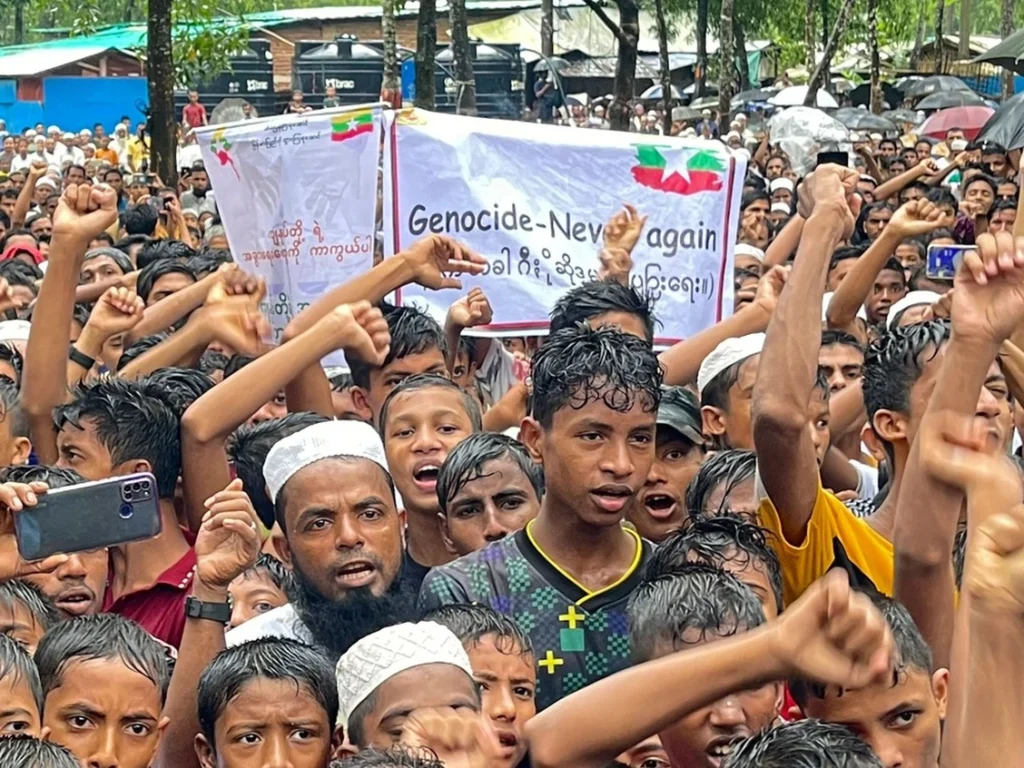The Rohingya are an ethnic minority from northwestern Myanmar. Predominantly Muslims, they are subject to constant discrimination in their Buddhist-majority country. Numerous state-driven campaigns of terror and scorched earth have taken place in efforts to drive the Rohingya out of Myanmar. Notable ones include the massacres of 1978, 1991, 2012 and 2017, each one with horrific accounts of burnings, killings, and rapes. In 2019, the International Court of Justice began proceedings on Myanmar, accused of genocide, while the International Criminal Court is still collecting evidence to begin prosecutions against Myanmar’s leadership accused of crimes against humanity.
Six Years After Their Darkest Hour, the Rohingya Have Been Abandoned
ASIA-UPDATES ON MYANMAR ROHINGYA GENOCIDE, 4 Sep 2023
Raïss Tinmaung | Ottawa Citizen - TRANSCEND Media Service

Rohingya refugees gather for a rally marking the sixth anniversary of genocide day, in Ukhia, Bangladesh, on Aug. 25, 2023, demanding their secured and dignified return to Myanmar. Photo by TANBIR MIRAJ /AFP via Getty Images
What is lacking is the international community’s attention to the crisis and its genuine willingness to help.
25 Aug 2023 – Aug. 25 marks the sixth anniversary of the last massacre of the Rohingya in Myanmar. Nearly half of their villages were exterminated and 800,000 people fled to refugee camps in Bangladesh. Today, the Rohingya still remain stranded in the refugee camps and the apartheid villages. They have been abandoned by the international community as other issues and conflicts have taken priority.
For the nearly one million Rohingya living in ultra-poverty in refugee camps, rations were cut from $12 per person to $10 per person to eventually $8 per person as of June 2023. With 27 cents a day, it becomes difficult to even have a bowl of rice and lentils once a day, let alone anything else that constitutes essential nutrients, especially needed for young developing children.
For the Rohingya that survived the massacres and remained in Myanmar, 153,000 of them live in internally displaced camps and 447,000 in villages with severe restrictions of movement, making it nearly impossible to earn a living, go to school, or be seen by a doctor. People in the camps live in severely overcrowded conditions and suffer from high rates of malnutrition, waterborne illnesses, and child and maternal deaths. It is common for children to die from recurring outbreaks of acute diarrhea.
The UN’s Independent Fact Finding Mission had described the situation of Rohingya in Myanmar as “deliberately inflicted conditions of life calculated to bring about the physical destruction of Rohingya” or “measures of slow death… living under the threat of genocide” The conditions still prevail today and many try to escape through human traffickers that promise to take them to Malaysia or Indonesia in exchange of their life savings — only to desert them in the Andaman Sea where they eventually perish.
The humanitarian response to the Rohingya crisis is also on a decline, which is evident from the severe ration cuts in the refugee camps. The World Food Program’s country brief (Bangladesh) from April 2023 highlighted a $56-million funding shortfall. This can be starkly contrasted with the global humanitarian response to the crisis in Ukraine: nearly $4 billion by the U.S. government alone, €670 million in EU civil protection mechanisms from the European Union and hundreds of millions, if not billions, in bilateral aid from countries all over the world.
Canada has also made a commitment to pursue accountability for crimes committed by Myanmar’s ruling junta in its strategy statements. It has expressed its intent to intervene in the proceedings against Myanmar at the International Court of Justice, which it has yet to fulfill.
Aug. 25 is another anniversary of the last massacre of the Rohingya. One anniversary after another passes, and the lives of the Rohingya in the refugee camps of Bangladesh and the segregated villages in Myanmar continue as before, stateless and hopeless. What is lacking is the international community’s attention to the crisis and its genuine willingness to help.
____________________________________________
Raiss Tinmaung is a Rohingya from Akyab (Sittwe) living in Ottawa.
Tags: Bangladesh, Burma, Genocide, Muslims, Myanmar, Refugees, Rohingya
DISCLAIMER: The statements, views and opinions expressed in pieces republished here are solely those of the authors and do not necessarily represent those of TMS. In accordance with title 17 U.S.C. section 107, this material is distributed without profit to those who have expressed a prior interest in receiving the included information for research and educational purposes. TMS has no affiliation whatsoever with the originator of this article nor is TMS endorsed or sponsored by the originator. “GO TO ORIGINAL” links are provided as a convenience to our readers and allow for verification of authenticity. However, as originating pages are often updated by their originating host sites, the versions posted may not match the versions our readers view when clicking the “GO TO ORIGINAL” links. This site contains copyrighted material the use of which has not always been specifically authorized by the copyright owner. We are making such material available in our efforts to advance understanding of environmental, political, human rights, economic, democracy, scientific, and social justice issues, etc. We believe this constitutes a ‘fair use’ of any such copyrighted material as provided for in section 107 of the US Copyright Law. In accordance with Title 17 U.S.C. Section 107, the material on this site is distributed without profit to those who have expressed a prior interest in receiving the included information for research and educational purposes. For more information go to: http://www.law.cornell.edu/uscode/17/107.shtml. If you wish to use copyrighted material from this site for purposes of your own that go beyond ‘fair use’, you must obtain permission from the copyright owner.
Read more
Click here to go to the current weekly digest or pick another article:
ASIA-UPDATES ON MYANMAR ROHINGYA GENOCIDE: